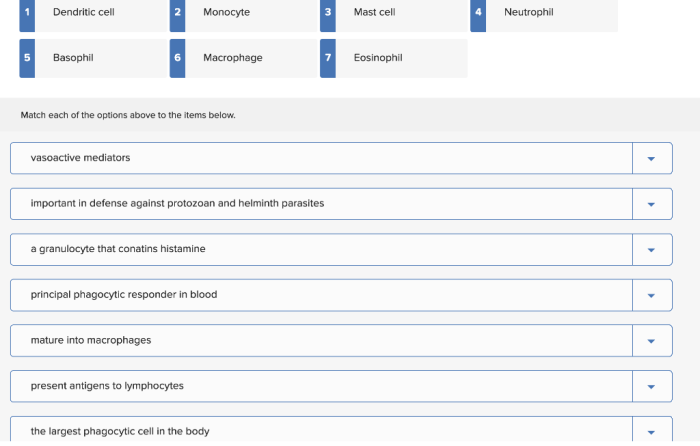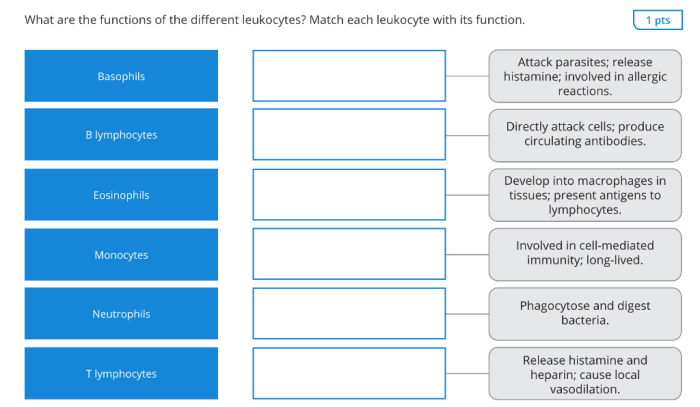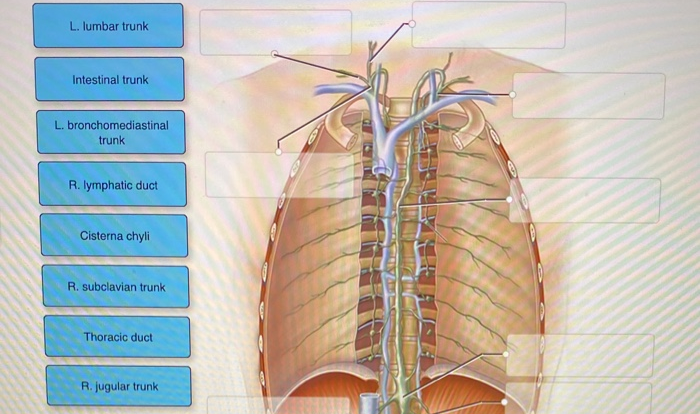Match each leukocyte listed with its correct defensive function. – The human immune system is a complex and dynamic network of cells, tissues, and organs that work together to defend the body against pathogens and other harmful substances. Leukocytes, also known as white blood cells, play a critical role in this defense system by identifying and eliminating foreign invaders.
This article provides a comprehensive overview of the various types of leukocytes and their specific defensive functions.
Leukocytes are classified into two main groups: myeloid cells and lymphoid cells. Myeloid cells include neutrophils, eosinophils, basophils, and monocytes/macrophages. Lymphoid cells include lymphocytes, which are further divided into B cells, T cells, and natural killer cells. Each type of leukocyte has unique characteristics and plays a specialized role in the immune response.
Leukocytes and Their Defensive Functions

Leukocytes, also known as white blood cells, are vital components of the immune system, responsible for defending the body against pathogens, foreign substances, and damaged cells. Different types of leukocytes have specialized defensive functions, working together to maintain the body’s health and protect it from infection and disease.
Neutrophils, Match each leukocyte listed with its correct defensive function.
Neutrophils are the most abundant type of leukocyte, accounting for 60-70% of the total leukocyte count. They are the first responders to infection and inflammation, quickly migrating to the site of injury or infection.
The primary defensive function of neutrophils is phagocytosis, the process of engulfing and destroying foreign particles. Neutrophils extend their pseudopodia, finger-like projections, around the particle, forming a phagocytic vacuole that encapsulates the particle. The vacuole then fuses with lysosomes, releasing digestive enzymes that break down the particle, killing it.
Neutrophils also release antimicrobial peptides and reactive oxygen species (ROS) to kill pathogens. They play a crucial role in acute inflammation, releasing cytokines and chemokines that attract other immune cells to the site of infection.
Eosinophils
Eosinophils are less common than neutrophils, accounting for 1-3% of the total leukocyte count. They are involved in defense against parasitic infections and allergic reactions.
Eosinophils have specialized granules containing toxic proteins, such as eosinophil peroxidase and major basic protein, which are released to kill parasites. They also release cytokines that activate other immune cells, such as macrophages and mast cells, to participate in the defense against parasites.
In allergic reactions, eosinophils are recruited to the site of allergen exposure and release their toxic granules, causing tissue damage and inflammation. This is why eosinophils are often associated with allergic conditions such as asthma and hay fever.
Basophils
Basophils are the least common type of leukocyte, accounting for less than 1% of the total leukocyte count. They are involved in allergic reactions and inflammation.
Basophils release histamine and other inflammatory mediators, such as leukotrienes and prostaglandins, which cause vasodilation, increased vascular permeability, and smooth muscle contraction. These effects contribute to the symptoms of allergic reactions, such as sneezing, runny nose, and itchy eyes.
Basophils also play a role in anaphylaxis, a severe allergic reaction that can be life-threatening. In anaphylaxis, basophils release large amounts of histamine and other inflammatory mediators, causing a sudden drop in blood pressure and difficulty breathing.
Lymphocytes
| Lymphocyte Type | Defensive Function | Key Characteristics | Examples |
|---|---|---|---|
| B cells | Produce antibodies that recognize and neutralize specific antigens | Surface immunoglobulin receptors | Plasma cells, memory B cells |
| T cells | Recognize and kill infected cells or foreign cells | Surface T cell receptors | Helper T cells, cytotoxic T cells, memory T cells |
| Natural killer cells | Kill infected cells and tumor cells | Lack surface antigen receptors | – |
| Regulatory T cells | Suppress immune responses to prevent excessive inflammation | Surface CD25 and FoxP3 markers | – |
Lymphocytes are responsible for adaptive immunity, the ability of the immune system to recognize and respond to specific pathogens. B cells produce antibodies that bind to specific antigens, marking them for destruction by other immune cells. T cells recognize and kill infected cells or foreign cells, and they also help activate other immune cells.
Monocytes/Macrophages
| Cell Type | Defensive Function | Key Characteristics | Examples |
|---|---|---|---|
| Monocytes | Circulate in the blood and migrate to tissues to become macrophages | Large, phagocytic cells | – |
| Macrophages | Phagocytose foreign particles, damaged cells, and pathogens | Fixed or mobile cells | Kupffer cells (liver), alveolar macrophages (lungs), osteoclasts (bone) |
Monocytes and macrophages are phagocytic cells that engulf and destroy foreign particles, damaged cells, and pathogens. They also release cytokines and chemokines to activate other immune cells and promote inflammation. Macrophages are found in various tissues throughout the body, where they play important roles in immune surveillance and defense.
FAQ Guide: Match Each Leukocyte Listed With Its Correct Defensive Function.
What is the primary function of neutrophils?
Neutrophils are the most abundant type of leukocyte and are responsible for phagocytosis, the process of engulfing and destroying foreign particles.
How do eosinophils contribute to the defense against parasitic infections?
Eosinophils release toxic substances that can damage and kill parasitic organisms.
What is the role of basophils in allergic reactions?
Basophils release histamine and other inflammatory mediators that contribute to the symptoms of allergic reactions.


